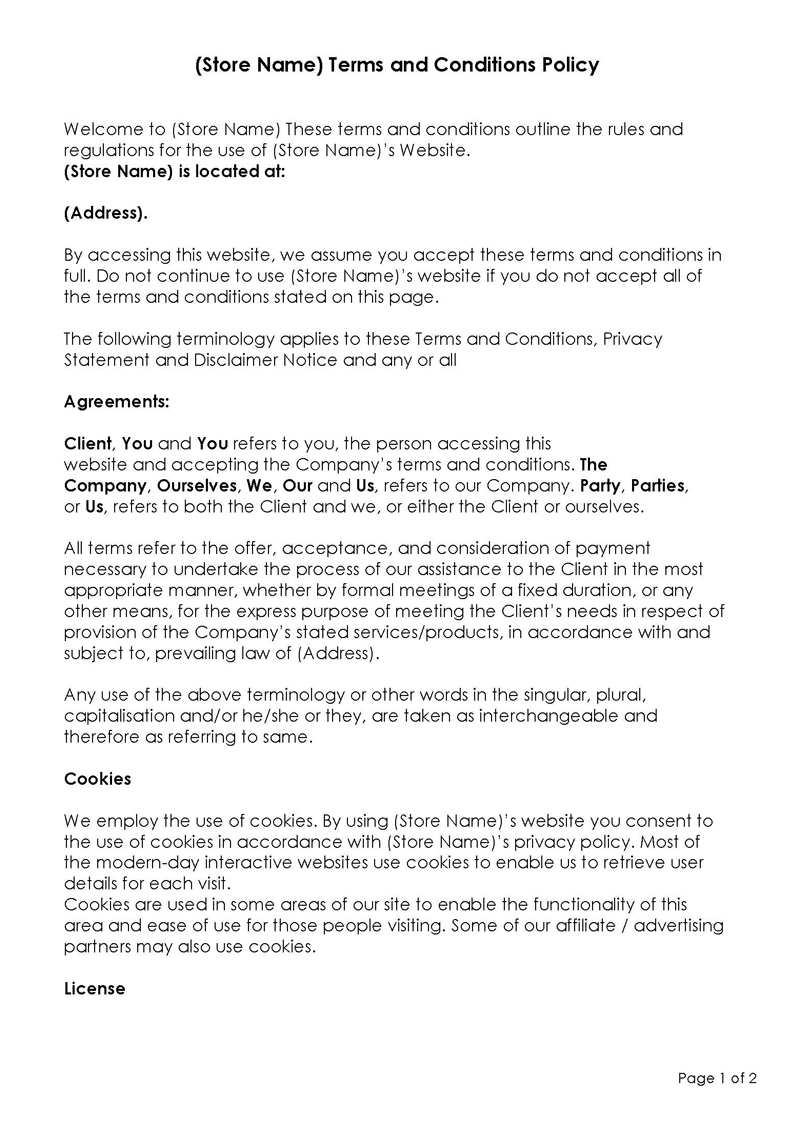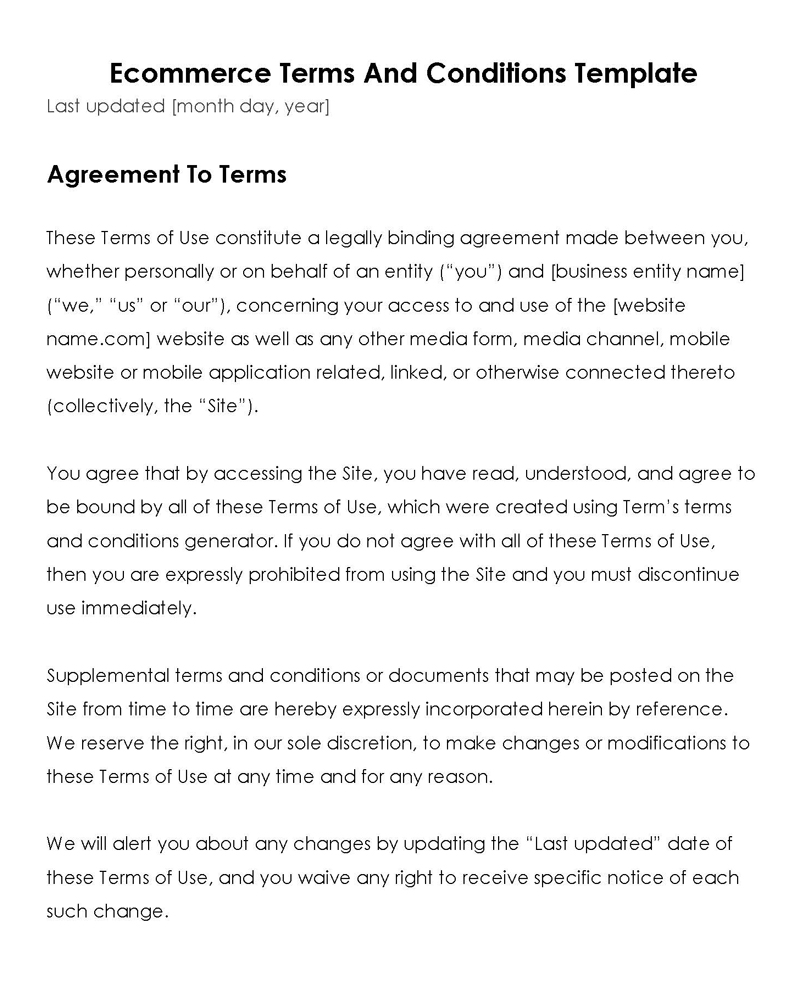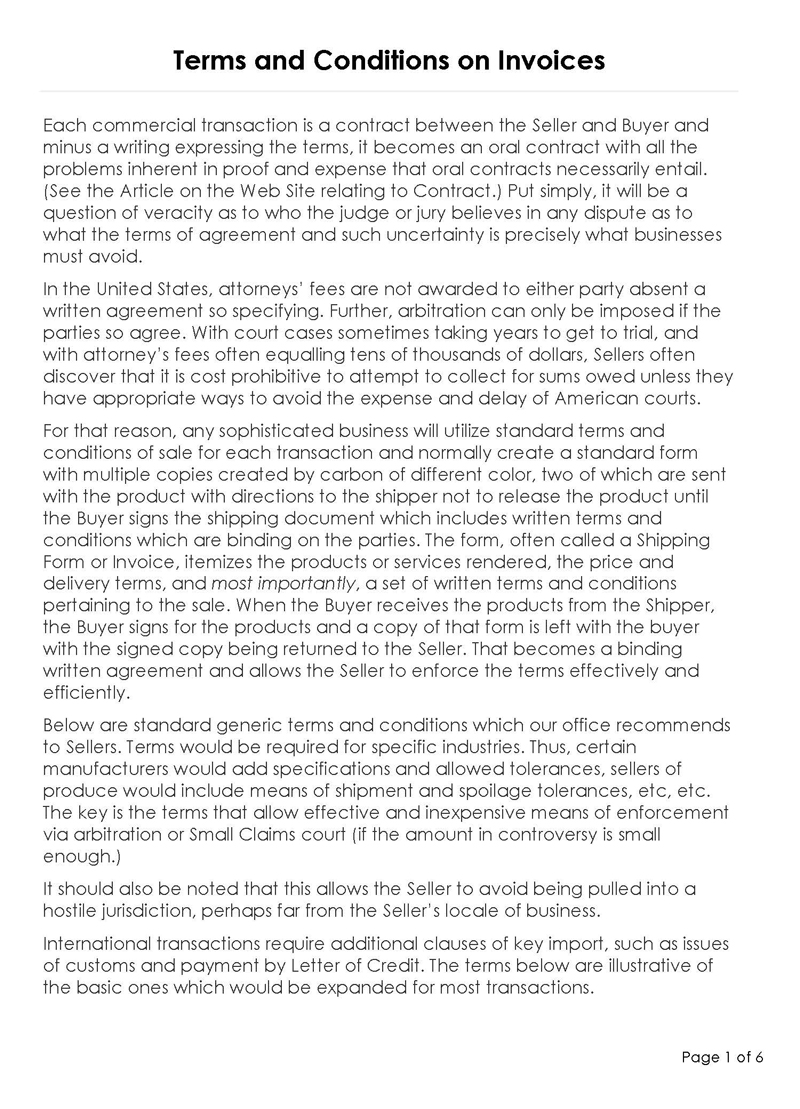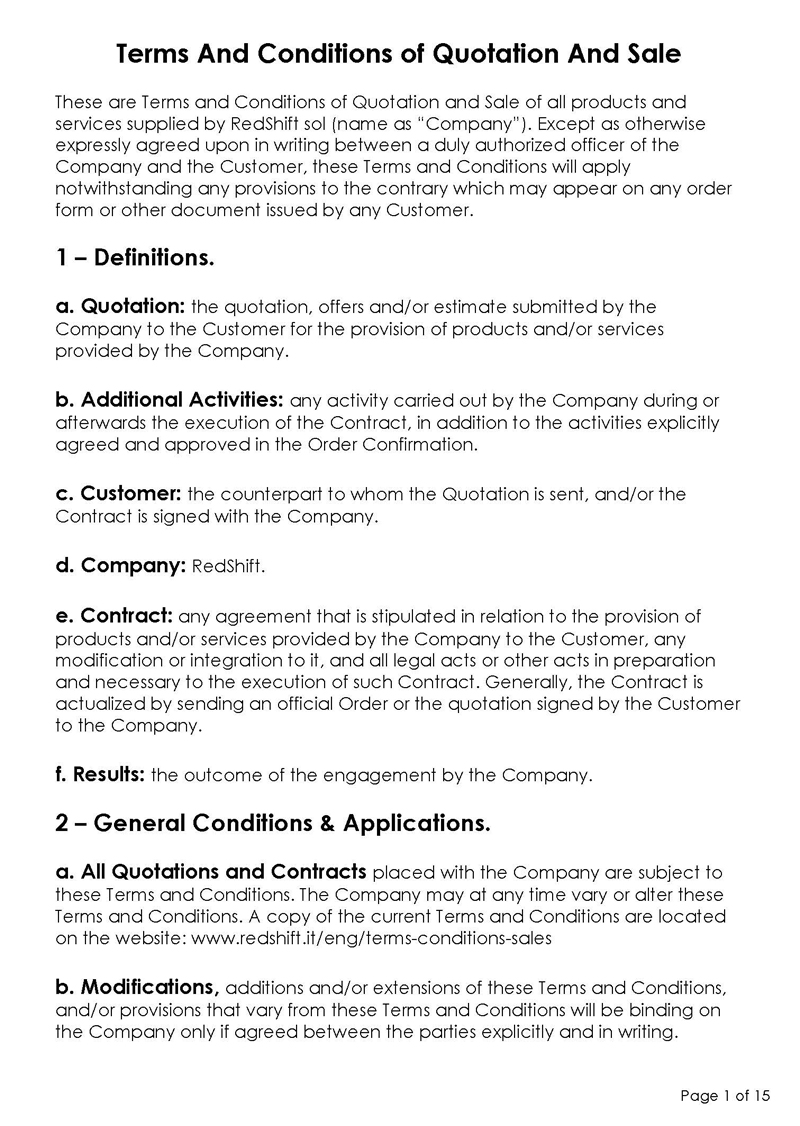Terms and conditions set the guidelines that each party involved in the transaction will abide by the rules during their interaction. While these are critical components, they are collectively written in a document known as a terms and conditions template or agreement. Such templates are standard among online businesses where consumers have to use their website or application. The template is legally binding once the consumer or user agrees. Once consumers agree to the T&C, they legally pledge not to abuse the site or application. In contrast, by providing it, the business vows to protect the consumer’s rights.
Terms and conditions or T&Cs are legally enforceable rules governing the interactions between a seller and buyer to prevent the abuse of the business’s and user’s rights.
They are applied to the appropriate use of the site or application, password security, intellectual property, registration procedures, and any other essential interaction between the business and the user.
Terms and Condition Examples




Terms and Conditions Agreement
T&C agreement is a protective instrument used by businesses to outline the rules guiding how users can utilize a website or software and the legal powers of the business owner if the user violates the guidelines.
E-commerce businesses use such agreements, websites, mobile apps, SaaS apps like WordPress blogs, Desktop apps, etc. The agreement is legally binding if the user agrees to its stipulations and proceeds to use the website or application.
Alternative name
A terms and conditions agreement can sometimes be referred to as
- Terms of use
- Terms of services
- Associated abbreviations ToU and ToS.
Why use it?
Using this agreement is not legally mandated; running a website or application without one exposes you to legal liabilities should the site or app be misused. Therefore, it is the site/app administrator’s first line of defense. Consequently, the fundamental incentive to use a T&C agreement is to legally protect the business by ensuring users have a set of rules they can refer to when using the site or app. This way, a business can protect its intellectual property and users from other abusive users and avoid rampant litigation.
T&C contracts are standard for all users in the same platform (site or app). They help users understand their legal obligations and rights before using the website or application. Also, terms and conditions are admissible evidence in court during lawsuits between companies and consumers.
Benefits of Using T&C Agreement
Without this agreement in place, a business can be limited in how it oversees its website while exposing its users to online exploitation.
Below is a list of significant reasons a business should consider using this agreement:
Intellectual property theft/rights
A business can protect its intellectual property through a T&C template. This is achieved by adding rules that govern the use of creative content placed on the website or app. For example, intellectual property can include brand names, logo, slogan, or other inimitable content. With a T&C agreement in place, the user vows to respect the business’s ownership rights, thus preventing copyright infringement.
Manage user’s expectations
A template helps the business administrator set boundaries on how users can use the website, app, or content. Well-defined terms of use let users know what they can or cannot expect from the company.
Remove or delete abusive users
With the T&C in place, a business can define its platform’s appropriate and inappropriate use and clarify the applicable consequences of abusive users. This gives the company the right to terminate abusive accounts or initiate appropriate consequences when users violate any of the terms and conditions stipulations.
Potential litigation
Such agreements add a protective layer in court when users sue a business. They can be presented in court to determine which party was legally liable for the issue brought in front of the court. The T&C agreement also declares the agreement’s jurisdiction, thus giving the company flexibility to choose a jurisdiction that suits their business.
Limit your responsibility
A template is an effective way for businesses to limit their legal liability regarding how their website or app is used and any errors in the content, such as mistakes and site/app crashes. In addition, legal liability can be limited using disclaimers or clauses in the T&Cs agreement.
Site rules and consequences for violating
Businesses use the agreements to outline the rules that govern every user and any interaction within the site or app. The agreement becomes the “constitution” of the interactions between the company and its consumers.
Prevent misunderstandings
By having the governing rules of using a site or app written, each party can consult the text whenever issues arise. This becomes crucial in conducting transactions or interactions without conflicts since everyone understands their rights and obligations.
Types of T&Cs
The templates vary depending on their utilization. It should reflect the use of the website or software. Therefore, since different websites and apps serve different purposes, there are multiple types of T&Cs:
Selling goods to a business
Companies can prepare terms and conditions to govern sales and purchases with other businesses. This type of template covers pricing, orders, delivery, payment terms, warranties, liability, and confidentiality of any transaction.
Selling goods to a consumer online
The template can be created to outline the rights and obligations of a company and its online consumers. The agreement can cover guidelines associated with registration, subscription, orders, payment methods, delivery, return policy, security, liability, cancellation of orders, etc.
Selling goods to a customer/consumer on business premises
Brick-and-mortar businesses can also use T&C. It governs how consumers make orders, return policy, warranties, liability, delivery, and other aspects of the transaction.
Selling services to a business
Companies that offer services to other businesses, for example, shipping companies, use this type of template. In addition, the contract outlines rules governing liability, intellectual property, orders, confidentiality, termination of orders, etc.
Selling services to a consumer online
T&C have to be applied when selling services to online consumers. For example, the T&Cs contract highlights the governing rules regarding payment, confidentiality, jurisdiction, prohibited functions/activities on the app or site, intellectual property protection, guidelines of cancellation of contract, etc.
Selling services to a customer on business premises
The template can be crafted to supervise the sale of services to consumers in person. The agreement stipulates the pricing, client obligations, payment terms, guarantees, liability limits, confidentiality, and disclaimers.
Basic Contents of Terms and Conditions
Generally, a business transaction has multiple aspects that this agreement can govern. The contract can be tailored to cover the key areas of the business-consumer interaction. When creating a template, certain clauses should be prioritized:
Disclaimer/introduction clauses
The T&Cs agreement should have a disclaimer or introduction clause at the beginning. An introduction clause should identify the who, what, where, when, why, and how the T&C are applicable. For example, a disclaimer declares that the consumers should accept the platform AS-IS and As-Available. This is used to manage users’ expectations and limit your responsibility.
Liability/corrections
Good terms and conditions should cover the consequences of any unintentional errors such as typos or human errors. It is almost impossible to run a flawless website or app; a liability clause exempts the site or app administrator from legal and financial liabilities stemming from such unprecedented mistakes.
Term and terminations
A clause that outlines the terms of use and actions that would result in temporary or permanent termination of use of the platform should be included. This clause is famous among SaaS applications. It protects users from being exploited by other users by giving the administrator the right to terminate the accounts of abusive users.
Governing laws
Every business is subject to specific governing laws based on its jurisdiction. Therefore, the template should indicate the jurisdiction under which they operate. In addition, this section is consulted for issues that require the intervention of state or federal laws.
Link to other websites
Businesses often incorporate third-party links in their site or applications to improve user experience, for example, affiliated links. Therefore, it is vital to include a clause that clarifies that the company is not responsible for issues the user may face when using third-party sites and applications. The clause should inform the user it is their responsibility to review third-party links’ T&C before using their services.
Prohibited activities
The template should list all the prohibited actions on the respective site or application. This section limits user-generated content, thus preventing the users’ from misusing the platform. Examples of user-generated content that can be prohibited include comments, usernames, language, etc.
Modifications and interruptions
A clause that offers the company the right to modify the site or app and declares that interruptions are likely to occur, thus affecting user experience, should be added. This section protects the business from claims of loss or damage during downtime.
Digital millennium copyright act notice and policy
Site and application administrators are subjected to specific guidelines stipulated by the Digital Millenium Copyright Act. The DMCA protects the intellectual property of the business and its users. Any copyright infringement is handled concerning the guidelines of the DMCA. This clause also declares that the users agree to share their content on the platform.
Privacy policy
Privacy is one of the most treasured commodities in the digital world. Typically, the privacy policy will be a separate text. It declares that the website or app owner will respect international privacy laws and protect any sensitive information shared by the user in confidence.
Policy on refunds and returns
It should include a refund and return policy clause. Most online consumers have no way to verify what they are ordering is what will be delivered; a refund and return policy should therefore offer consumers a guarantee that the company will fulfill their orders to meet their expectations, and if not, they can return the item or get a refund if the service was unsatisfactory.
Payment terms of the transaction
A section that declares how payment works for services or goods purchased through the platform should be provided. This section outlines the payment methods, free trials, subscription packages, cancellations, due dates, etc.
Warranty disclaimer clause
The agreement should declare circumstances under which the website or application owner cannot warranty goods or services obtained from the platform. Businesses can include as-is warranty disclaimers or time-bound warranties. Most high-risk businesses will offer as-is warranty disclaimers.
Delivery policy
Delivery is a vital component of a good consumer experience. Therefore, businesses should include a delivery policy informing consumers how delivery is made, when order is eligible for delivery, and any applicable terms like a delivery fee etc.
Contact information clause
Consumers will usually have questions or feedback to convey to the business. Therefore, the contract should have a clause that guides users on how to contact the company. This section can include customer care lines, links, phone numbers, and mailing addresses.
Tips for Writing Terms and Conditions
When writing the contracts, it should cover the most critical user experience and associated business model aspects.
In addition, the following writing tips can be incorporated to ensure the document effectively protects both parties:
Do not copy content from other websites
You should avoid copying the T&C of another company. These are meant to be unique to the specific website or application. Businesses in the same industry and with a similar target audience will arguably run their companies under different rules.
Write in clear/concise language and avoid legalese
As much as a T&Cs agreement is a legal document, it should be written in an easy-to-understand language. Users from different backgrounds should be able to understand what they agree to. Easy comprehensible T&Cs agreements are also easier to enforce.
Where to Display T&C?
It should be strategically placed so that users can see before interacting with the site or app. The legal enforceability of the T&Cs can be compromised if they are purposefully placed in a position where users won’t notice.
The template can be placed in the following key places:
- Website footer: The T&Cs can be placed in the website footer. A website footer is an area where users are known to look for important information like contact information and T&Cs.
- As a pop-up: Adding the agreement as a pop-up is an effective way of bringing the contract to the users’ attention.
- Checkout screen/form: It can be placed to mark the end of a user journey, for example, before completing a subscription. Users can choose to agree to the T&Cs before checking out. A link can be added to direct them to the agreement.
- Signup/login form: Companies are also known to place the T&C before users sign up or log in. The user can see the T&C before interacting with the platform.
note
Users should always be given the option to agree or reject the terms and conditions agreement.
Frequently Asked Questions
Terms and conditions are not legally required. However, it is always recommended that companies use the templates to protect themselves and consumers from any probable issues during interactions.
No. The GDPR does not mandate that website and application owners should use terms and conditions. However, the GDPR requires website owners to have a privacy policy.
The agreement is only enforceable if the user agrees. The simplest way to make the T&Cs contract enforceable is by adding a check-box where the user clicks to accept the T&Cs. Alternatively, an “I Agree” button can be added to this effect.
The simplest method of getting the users’ consent to applicable T&Cs is adding an express consent button or checkbox. Then, the user clicks to accept to indicate they have read and accepted the T&C.




